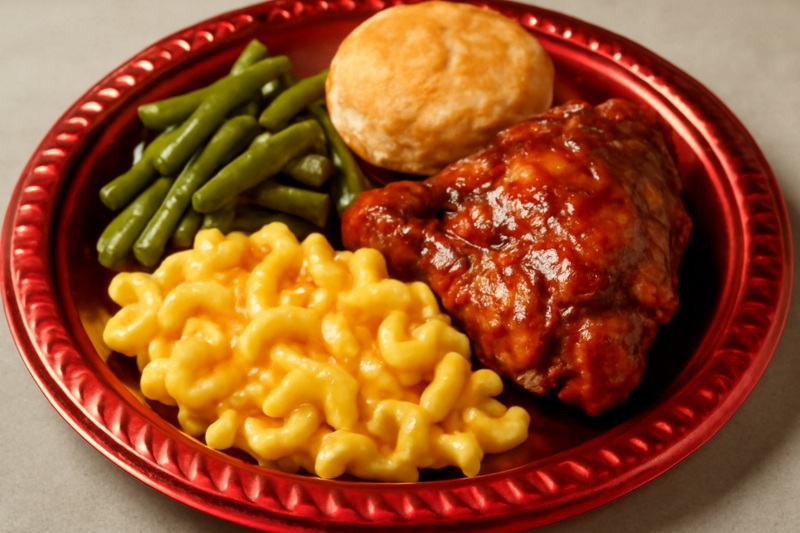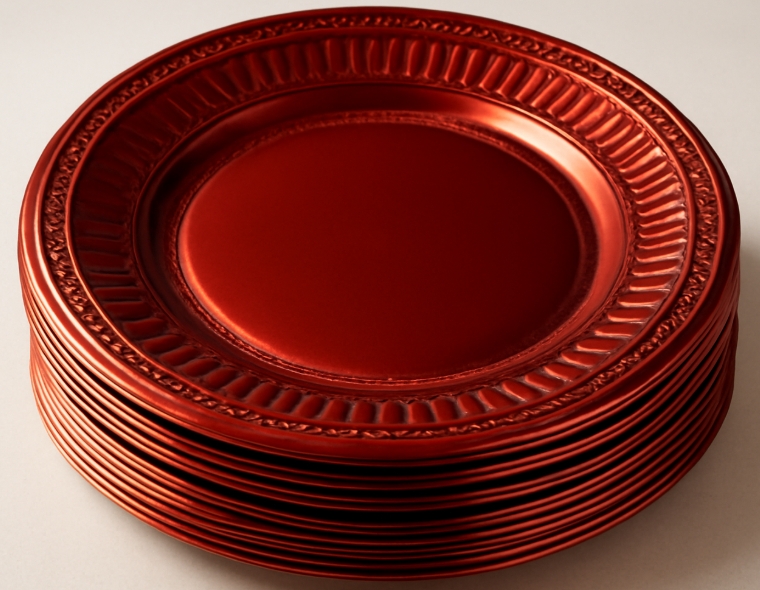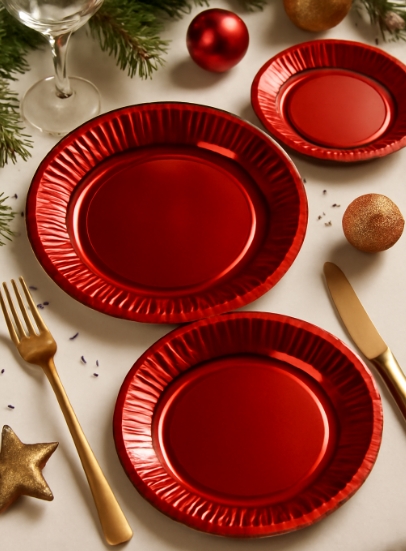
Content Menu
● Understanding Metallic Red Disposable Plates
>> What Are Metallic Red Disposable Plates?
>> Common Materials Used
● Safety Standards and Food-Grade Certification
>> Food-Grade Plastics and Coatings
>> Regulatory Oversight
● Potential Health Risks of Metallic Finishes
>> The Metallic Coating: What Is It?
>> Risks of Metallic Coatings
>>> Flaking and Migration
>>> Chemical Leaching
>>> Heat and Food Interaction
● Environmental and Practical Considerations
>> Durability and Convenience
>> Environmental Impact
● Best Practices for Safe Use
>> Choosing the Right Plate
>> Safe Usage Tips
>> Proper Disposal
● Comparing Metallic Red Disposable Plates to Other Options
● How to Identify Safe Metallic Red Disposable Plates
>> Check for Certifications
>> Manufacturer Reputation
>> Product Testing
● Real-World Usage Scenarios
>> Parties and Events
>> Catering and Food Service
>> Home Use
● Innovations in Metallic Red Disposable Plates
>> Eco-Friendly Alternatives
>> Improved Coatings
● Common Myths About Metallic Red Disposable Plates
>> Myth 1: All metallic red disposable plates are unsafe.
>> Myth 2: The metallic finish always contaminates food.
>> Myth 3: Metallic red disposable plates cannot be recycled.
● Tips for Hosting with Metallic Red Disposable Plates
● Conclusion
● Frequently Asked Questions (FAQ)
>> 1. Are metallic red disposable plates microwave-safe?
>> 2. Can I serve hot foods on metallic red disposable plates?
>> 3. Are metallic red disposable plates recyclable?
>> 4. Is it safe to use metallic red disposable plates for acidic foods, such as tomato-based dishes?
>> 5. What should I do if I notice the metallic coating flaking off my disposable plate?
The allure of a metallic red disposable plate is undeniable. Whether for a festive holiday gathering, a wedding, or a themed party, these plates add a vibrant splash of color and a touch of luxury to any table setting. But as visually appealing as they are, a crucial question arises: are metallic red disposable plates safe for food use? This comprehensive article explores the materials, manufacturing processes, potential health risks, and best practices associated with metallic red disposable plates, providing clarity for consumers and event planners alike.

Understanding Metallic Red Disposable Plates
What Are Metallic Red Disposable Plates?
Metallic red disposable plates are single-use tableware items, typically made from plastic or paper, that feature a shiny, metallic red finish. This finish is achieved through various methods, such as applying a thin metallic coating or using metallic pigments in the manufacturing process. These plates are designed to be both decorative and functional, offering a striking alternative to traditional white or clear disposable plates.
Common Materials Used
The most prevalent materials for metallic red disposable plates include:
- Polystyrene (PS): A sturdy plastic often chosen for its rigidity and ability to hold vibrant colors and finishes.
- Polypropylene (PP): Another food-grade plastic known for its flexibility and safety.
- Paper with Metallic Coatings: Sometimes, paper plates are coated with a thin layer of metallic material to achieve the desired look.
Each of these materials has distinct properties that affect both safety and usability.
Safety Standards and Food-Grade Certification
Food-Grade Plastics and Coatings
For any disposable plate to be deemed safe for food use, it must be made from food-grade materials. This means the base plastic or paper and any coatings or pigments must not leach harmful chemicals into food, especially when in contact with hot, acidic, or greasy foods. Reputable manufacturers use plastics like PS or PP that comply with food safety regulations and are free from toxic substances such as BPA and phthalates.
Regulatory Oversight
In many countries, government agencies regulate materials that come into contact with food. Plates labeled as food-grade or certified for food use have undergone testing to ensure they do not release unsafe levels of chemicals under normal use conditions. Some products also carry warnings about potential exposure to certain chemicals, depending on regional regulations.
Potential Health Risks of Metallic Finishes
The Metallic Coating: What Is It?
The metallic sheen on disposable plates is typically achieved through:
- Vacuum Metallization: Depositing a thin layer of metal, such as aluminum, onto the plate's surface.
- Metallic Pigments: Incorporating metallic-looking pigments into the plastic or coating.
While these techniques create the desired visual effect, they introduce questions about durability and chemical stability.
Risks of Metallic Coatings
Flaking and Migration
One concern with metallic coatings is the potential for the metallic layer to flake off, especially when exposed to acidic foods, hot liquids, or abrasive utensils. If the coating is not properly bonded or protected by a food-safe overcoat, small particles could end up in your food. This is particularly problematic with aluminum coatings, which can be soft and prone to chipping or washing away under heat or acidic conditions.
Chemical Leaching
Certain plastics and metallic finishes may contain or release substances such as:
- Styrene: Found in polystyrene, classified as a potential human carcinogen, especially when heated.
- Aluminum: While the amount used in coatings is small, ingestion of aluminum particles is generally undesirable and has been linked to health concerns in high quantities.
- Non-Food-Safe Overcoats: Some imported plates may use non-food-approved protective layers, which could degrade and contaminate food when exposed to heat or acids.
Heat and Food Interaction
Using metallic red disposable plates for very hot or highly acidic foods increases the risk of chemical migration from the plate to the food. Most manufacturers recommend avoiding direct contact with extremely hot items to minimize this risk.
Environmental and Practical Considerations
Durability and Convenience
Metallic red disposable plates are designed for single use, offering convenience and eliminating the need for washing. High-quality versions are sturdy enough to hold a variety of foods without bending or breaking, making them suitable for both indoor and outdoor events.
Environmental Impact
Most metallic red disposable plates are made from plastics that are recyclable, though local recycling capabilities vary. The metallic coating can sometimes complicate recycling processes. Paper-based plates with metallic finishes are generally not compostable or recyclable due to their coatings.

Best Practices for Safe Use
Choosing the Right Plate
- Look for Food-Grade Certification: Ensure the plates are labeled as food-safe or certified for food use.
- Check for BPA-Free and Non-Toxic Labels: These indicate the absence of certain harmful chemicals.
- Read Manufacturer Instructions: Some plates specify temperature limits or restrictions on use with certain foods.
Safe Usage Tips
- Avoid Using with Very Hot or Acidic Foods: This reduces the risk of chemical migration or coating flaking.
- Inspect for Damage: Do not use plates with visible chips, cracks, or flaking metallic surfaces.
- Single Use Only: Do not reuse disposable plates, as repeated washing or use can degrade the coating and increase risk.
Proper Disposal
- Recycle Where Possible: Check if your local recycling program accepts the type of plastic used.
- Avoid Composting Metallic-Coated Paper Plates: The metallic finish is not biodegradable and can contaminate compost.
Comparing Metallic Red Disposable Plates to Other Options
| Plate Type | Food Safety | Heat Resistance | Environmental Impact | Visual Appeal |
| Metallic Red Disposable Plate | Safe when food-grade, but avoid high heat/acid | Moderate (check label) | Recyclable (varies) | High (festive, elegant) |
| Standard Plastic Plate | Generally safe if food-grade | Moderate | Recyclable | Moderate |
| Paper Plate | Safe for short-term use | Low (not for hot foods) | Compostable (if uncoated) | Basic |
| Ceramic/Reusable Plate | Safest, non-reactive | High | Reusable (eco-friendly) | Varies |
How to Identify Safe Metallic Red Disposable Plates
Check for Certifications
When purchasing metallic red disposable plates, look for packaging that clearly states the product is food-safe, BPA-free, and compliant with local food safety regulations. Certifications or marks from recognized authorities can provide additional assurance.
Manufacturer Reputation
Choose products from reputable manufacturers or brands known for quality control and adherence to safety standards. Reading customer reviews and seeking recommendations can also help in making an informed choice.
Product Testing
Some consumers prefer to conduct their own simple tests before using new disposable plates, such as checking for odors, discoloration, or residue when exposed to hot water. While not a substitute for laboratory testing, these steps can sometimes reveal obvious issues.
Real-World Usage Scenarios
Parties and Events
Metallic red disposable plates are popular for themed parties, weddings, and holiday events. They offer a visually striking way to enhance the decor and are especially favored for occasions where red is a significant color, such as Valentine's Day or Christmas.
Catering and Food Service
Caterers often use metallic red disposable plates for upscale events, as they provide a sophisticated look without the need for extensive cleanup. However, professional caterers are usually careful to select plates that meet food safety standards and are suitable for the types of food being served.
Home Use
For family gatherings or casual celebrations, metallic red disposable plates are a convenient option. However, it is important to remember the limitations regarding heat and acidity to ensure safe use.
Innovations in Metallic Red Disposable Plates
Eco-Friendly Alternatives
With growing environmental awareness, some manufacturers are developing metallic red disposable plates made from biodegradable materials or using water-based metallic inks. These options aim to reduce the environmental impact while maintaining the desired aesthetic.
Improved Coatings
Advances in coating technology have led to more durable and food-safe metallic finishes. Some plates now feature protective layers that prevent flaking and resist chemical migration, even when used with warm foods.
Common Myths About Metallic Red Disposable Plates
Myth 1: All metallic red disposable plates are unsafe.
Not all metallic red disposable plates pose a risk. Plates made from food-grade materials and manufactured according to safety standards are considered safe for their intended use. The key is to verify the product's certifications and intended uses.
Myth 2: The metallic finish always contaminates food.
A properly applied and food-safe metallic finish should not contaminate food under normal use. Issues usually arise when plates are used with very hot or acidic foods, or if the coating is poor quality.
Myth 3: Metallic red disposable plates cannot be recycled.
While recycling can be more complicated due to the metallic coating, many metallic red disposable plates made from certain plastics are accepted in recycling programs. Always check local guidelines.
Tips for Hosting with Metallic Red Disposable Plates
- Coordinate with Other Tableware: Pair metallic red disposable plates with gold or silver cutlery for a cohesive, elegant look.
- Use Plate Liners: For extra safety, consider placing a paper doily or liner on the plate before adding food, especially if serving hot or acidic dishes.
- Dispose Responsibly: Set up clearly labeled bins for recycling and trash to encourage guests to dispose of plates properly.
Conclusion
Metallic red disposable plates can be safe for food use, provided they are manufactured from food-grade materials, use non-toxic metallic finishes, and are used according to manufacturer guidelines. The key risks involve potential chemical migration from metallic coatings, especially when exposed to heat or acidic foods, and the possibility of flaking if the coating is not durable. To ensure safety, always choose reputable brands that clearly label their products as food-safe, BPA-free, and suitable for the intended use. Avoid using these plates for extremely hot or acidic dishes, and never reuse them.
While metallic red disposable plates offer undeniable aesthetic appeal and convenience, consumers must remain vigilant about their choices, balancing visual impact with health and environmental considerations.

Frequently Asked Questions (FAQ)
1. Are metallic red disposable plates microwave-safe?
Most metallic red disposable plates are not microwave-safe. The metallic coating can spark or cause uneven heating in the microwave, potentially damaging both the plate and the appliance. Always check the packaging for microwave safety instructions before use.
2. Can I serve hot foods on metallic red disposable plates?
You can serve warm foods on many metallic red disposable plates, but it is best to avoid extremely hot or boiling foods. High temperatures can cause chemical migration or damage the metallic coating, increasing the risk of flaking or leaching. Always follow the manufacturer's temperature guidelines for safe use.
3. Are metallic red disposable plates recyclable?
Some metallic red disposable plates made from plastics like polystyrene or polypropylene are recyclable, but the metallic coating may complicate the recycling process. Always check local recycling guidelines and look for recycling symbols on the packaging.
4. Is it safe to use metallic red disposable plates for acidic foods, such as tomato-based dishes?
It is generally advisable to avoid using metallic red disposable plates for highly acidic foods. Acidic ingredients can react with the metallic coating, causing it to flake or leach into the food. Opt for plain, food-grade plastic or ceramic plates when serving acidic dishes.
5. What should I do if I notice the metallic coating flaking off my disposable plate?
If you observe any flaking or chipping of the metallic coating, do not use the plate for serving food. Discard any damaged plates to prevent ingestion of metallic particles, which could pose health risks.

















